Cassini says goodbye to Saturn

Cool image time! The picture above, reduced in resolution to show here, was taken in October 2016 during one of Cassini’s last distant orbits that gave it a global view of Saturn and its rings. Since it began its dives close to the gas giant such views have not been possible.
The mission ends this coming Saturday with a dive into Saturn. It was launched in October 1997, and after a seven year journey has spent the last thirteen years in orbit around the planet, providing us the first long term glimpse of a gas giant as its seasons evolved.
Cassini has been orbiting Saturn for nearly a half of a Saturnian year but that journey is nearing its end. This extended stay has permitted observations of the long-term variability of the planet, moons, rings, and magnetosphere, observations not possible from short, fly-by style missions.
When the spacecraft arrived at Saturn in 2004, the planet’s northern hemisphere, seen here at top, was in darkness, just beginning to emerge from winter (see Cassini’s Holiday Greetings). Now at journey’s end, the entire north pole is bathed in the continuous sunlight of summer.
The spacecraft was also able to observe the seasonal changes that occurred to Titan. It also studied the plumes coming from the tiger stripe cracks on Enceladus, shown below the fold in a movie created by Cassini over a 14 hour time period in August 2017.
I expect that scientists will be exploring Cassini’s data archive for decades, finding many things not noticed in their initial viewing. Unfortunately, we will not have another spacecraft taking new pictures in orbit around Saturn to compare with Cassini’s past images for many decades to come. On Saturday, we go blind.

On Christmas Eve 1968 three Americans became the first humans to visit another world. What they did to celebrate was unexpected and profound, and will be remembered throughout all human history. Genesis: the Story of Apollo 8, Robert Zimmerman's classic history of humanity's first journey to another world, tells that story, and it is now available as both an ebook and an audiobook, both with a foreword by Valerie Anders and a new introduction by Robert Zimmerman.
The print edition can be purchased at Amazon or from any other book seller. If you want an autographed copy the price is $60 for the hardback and $45 for the paperback, plus $8 shipping for each. Go here for purchasing details. The ebook is available everywhere for $5.99 (before discount) at amazon, or direct from my ebook publisher, ebookit. If you buy it from ebookit you don't support the big tech companies and the author gets a bigger cut much sooner.
The audiobook is also available at all these vendors, and is also free with a 30-day trial membership to Audible.
"Not simply about one mission, [Genesis] is also the history of America's quest for the moon... Zimmerman has done a masterful job of tying disparate events together into a solid account of one of America's greatest human triumphs."--San Antonio Express-News


Not sure I agree that we won’t have a long-term Saturnian presence for ‘many decades to come’. There are enough players in the space game (and more entering) that I think someone will send something. Of course, they’ll have to do it for less than Cassini’s $150M/year amortized cost.
Blair Ivey: Development for Cassini began in the 1980s. If we say 1987, it took a decade to bring it to the launchpad. Then it took seven years to reach Saturn. That’s 17 years, minimum, as a rough estimate. I would probably add at least five years for budget negotiations and the typical government confusions. That gets us to 23 years.
I think a quarter century is still optimistic, considering the overall inability of the federal government these days to get much of anything done. NASA is tightly focused on Mars right now. Saturn is a distraction politically. Assuming nothing changes and we are still dependent on the government for missions like this for many years, we are looking at least three decades before another spacecraft enters Saturn orbit.
Then again, if the Falcon Heavy starts flying and satellite miniaturization continues apace, my pessimism could be misplaced.
Actually, I see it as Cassini saying not goodbye, but “Hello Saturn” !
After flirting for so long with Saturn, Cassini now can say, “Hey Lady, how about a quick dance before the lights go out?”.
Thanks for the memories.
Robert:
If the next Saturn probe is a government directed project, you’re likely right. I’d lay odds it won’t be.
When Cassini was developed, we (humans) were developing new tech: we’d never sent a long-term probe to Saturn. This is now known tech, with a serious amount of operational history. I’d think the development cycle would be shortened thereby.
Thank you Bob! It’s an amazing universe!